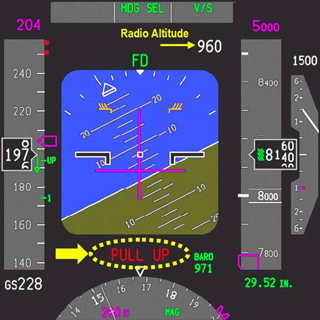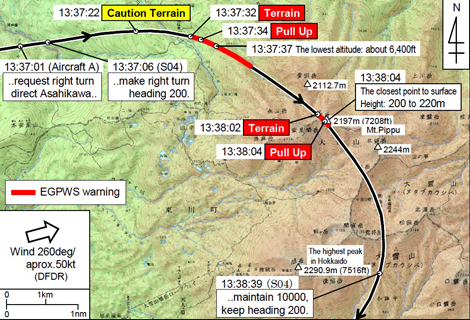
Air Nippon flight ANA325 – Boeing B737-800 (JA-55AN)
The occurrence of Air Nippon flight ANA325 covered by this report falls under the category of “A case where aircraft crew executed an emergency maneuver during navigation in order to avoid a contact with the ground” as stipulated in Clause 5, Article 166-4 of the Ordinance for Enforcement of the Civil Aeronautics Act of Japan and is classified as an aircraft serious incident.
On Tuesday, October 26, 2010, a Boeing 737-800, registered JA55AN, operating Air Nippon flight ANA325, took off from Chubu Centrair International Airport for Asahikawa Airport as the scheduled Air Nippon flight ANA325, under the wet lease agreement with All Nippon Airways Co.,Ltd.,
When the aircraft was descending toward Asahikawa Airport following an air traffic controller’s instructions near the destination aerodrome, its ground proximity warning system (GPWS) issued a warning at about 6,800 ft about 30 km east of Asahikawa City, Hokkaido Prefecture. The aircraft took an emergency maneuver and landed at Asahikawa Airport at 14:05 Japan Standard Time (JST: UTC+ 9hr, unless otherwise stated all times are indicated in JST on a 24-hour clock).
There were 57 persons on board, consisting of the PIC, five other crewmembers, and 51 passengers, but no one was injured.
With the renewed “TERRAIN” and “PULL UP” warnings, the Aircraft A took an evasive maneuver, by rotating up and increased engine thrust. At this moment the Air Nippon flight ANA325 was closest to the peak of Mt. Pippu with an elevation of 2,197 m (7,208 ft). Its height from the ground as recorded on the DFDR and EGPWS was about 200 to 220 m.
- The Aircraft A requested Sapporo Control for returning to Asahikawa Airport with a right turn while descending at about 7,700 ft near a point, 13 nm east of Asahikawa Airport, and a right descending turn was started toward heading 200° under Sapporo Control’s instructions. Few seconds after the Aircraft A started the turn, the “CAUTION TERRAIN” alert-message was issued and 10 seconds later, the “TERRAIN” and “PULL UP” warnings were issued. The Aircraft A performed an evasive maneuver following the EGPWS warnings.
- The Radar Controller decided to start radar vectoring for the Aircraft A because it would minimize a delay for landing. But it is possible that this serious incident could have been prevented from occurring, if he had selected to process the situation safely while considering the comprehensive workload of the sector.
- There is a mountainous area to the east of Asahikawa Airport and therefore, it is impossible to make a descent toward the area even if a horizontal separation is secured. It is probable that the Radar Controller made an inappropriate judgment when he radar-vectored the Aircraft A to the east.
- Because the Radar Controller had focused on securing a separation with the holding Aircraft B, it is probable that he forgot to check the MVA.
- It is probable that because of the Radar Controller’s partial recognition of the Aircraft A’s critical situation, his vague positive situational recognition and less awareness of the MVA, he forgot again to confirm the MVA when he instructed the Aircraft A to descend for the second time.
- The Coordinator was preoccupied with coordination with Asahikawa Airport; therefore, it is probable that she could not monitor the Radar Controller’s instructions and could not provide any advice to him on confirming the MVA.
- It is possible that the Radar Controller and the Coordinator lacked effective cooperation with each other; hence, the Coordinator could not correct the Radar Controller’s instructions for the Aircraft A to descend below the MVA.
- It is probable that because the PIC believed the controller was applying the MVA, he continued the flight without questioning the controller about the instructions.
- It is probable that if the FO had given advice to the PIC in an appropriate manner based on the information from the VSD, the ground proximity would not have occurred and the EGPWS warnings would not have been issued.
- It is highly probable that the PIC and the FO had recognition that the Aircraft A was being vectored to the east toward the mountainous area and they were somewhat reluctant to follow the instructions, but they did not talk about it.
Probable Causes
It is highly probable that this serious incident occurred because the Aircraft A experienced a ground proximity and its flight crew took an emergency maneuver responding to its EGPWS warnings during its descent toward its destination aerodrome, Asahikawa Airport, under the ATC instructions.
It is probable that the ground proximity occurred because: the Radar Controller instructed the Aircraft A to descend below the MVA without confirming it; its flight crew did not question the Radar Controller on the descent instruction in spite of awareness of being vectored to the east toward the mountainous area. It is probable that the Radar Controller forgot to confirm the MVA because his attention was focused on securing a separation with the holding Aircraft B.
It is probable that the flight crew did not question the air traffic controller about the instructions because: the PIC believed the controller was applying the MVA; the FO gave no advice to the PIC in spite of his VSD based recognition of the approach to the mountainous area.
Download Report


0 Comments